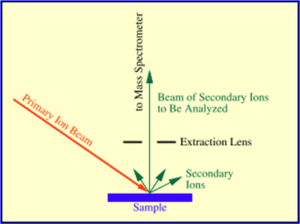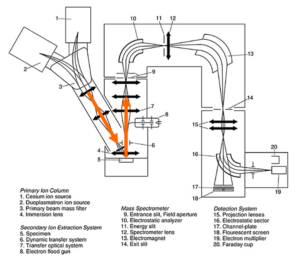
The CAMECA IMS 4f ion microprobe is a tool for investigating isotopic composition in the chemical, material, geological and biological sciences. All elements (H to U) can be detected in depth profiling, surface, bulk and microanalysis modes. Detection limits are in the ppb range with depth resolution of 10 nm and lateral resolution of ~ 3µm.Typical applications include in-depth compositional analysis of high performance materials, isotopic ratios in terrestrial/extraterrestrial specimens, localization/imaging of 13C, 15N- labeled molecules in biological materials.
The CAMECA IMS 4f is based on the phenomenon of ion- induced sputtering of a solid sample by an energetic primary ion beam, typically consisting of oxygen or cesium ions at beam energy of 5 – 20 keV. The interaction of the primary ions with the sample surface (“sputtering”) has three major effects: (1) It leads to a mixing of the upper layers of the sample, resulting in an amorphization of the surface; (2) atoms from the primary ion beam are implanted in the sample and (3) some secondary particles (atoms and small molecules) are ejected from sample.
 Among the ejected particles are electrically neutral, as well as positively and negatively charged species. Charged particles of one polarity (“secondary ions”) can then be extracted from the sputtering area with the help of an electrical field between the sample and an extraction lens. These accelerated secondary ions constitute a secondary ion beam which is then led into a mass spectrometer. There, the secondary ions are sorted by mass (and energy) and finally counted in an ion detector (which can be an electron multiplier, a Faraday cup or a channel plate). The count rates of different secondary ion species give information about the composition of the sample in the sputtered area. Since the size of the sputtered area depends only on the primary ion beam diameter, which typically is in the order of micro-meter, a SIMS analysis has a relatively high lateral resolution.
Among the ejected particles are electrically neutral, as well as positively and negatively charged species. Charged particles of one polarity (“secondary ions”) can then be extracted from the sputtering area with the help of an electrical field between the sample and an extraction lens. These accelerated secondary ions constitute a secondary ion beam which is then led into a mass spectrometer. There, the secondary ions are sorted by mass (and energy) and finally counted in an ion detector (which can be an electron multiplier, a Faraday cup or a channel plate). The count rates of different secondary ion species give information about the composition of the sample in the sputtered area. Since the size of the sputtered area depends only on the primary ion beam diameter, which typically is in the order of micro-meter, a SIMS analysis has a relatively high lateral resolution.
 By carrying out mass spectrometry on the secondary ions, qualitative and quantitative analysis of all elements is possible by this technique, which is known as secondary ion mass spectrometry (SIMS).
By carrying out mass spectrometry on the secondary ions, qualitative and quantitative analysis of all elements is possible by this technique, which is known as secondary ion mass spectrometry (SIMS).
SIMS can be used for practically all elements of the periodic table, including hydrogen. SIMS allows the routine measurement of many trace elements at very low concentration (ppb-range). And since ions of different mass are measured separately, SIMS is ideally suited for the study of isotopic compositions of small samples.
During a measurement, the sample is slowly sputtered (eroded) away and that is why SIMS is capable of measuring depth profiles and perform 3-D measurements.
If you would like to submit samples for analysis, please contact Dr. Stan Verkhoturov.


